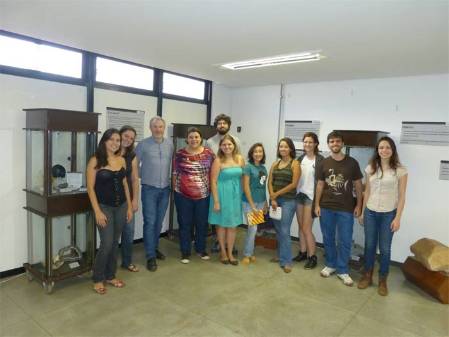This March I taught a course on collections management at the University of Brasilia (UnB) in the capital of Brazil. The class included both undergraduate and postgraduate students studying Geology, Museology and Art, mainly at UnB. This is the third time that I have presented a similar course in Brazil with previous courses delivered at UnB and the Museu Goeldi in Belem.
After the course I asked the students 'what was the most important thing you learned?' To illustrate the course contents, a summary of their answers is included here. There is also a picture of some of the less friendly Brazilian inhabitants I encountered!
Me with some of the class in the display area of the Museum of Geosciences at the University of Brasilia.
The course draws on examples from my 20 years of experience in managing microfossil collections, but the principles covered are relevant to the management of a wide range of natural history collections. Previous classes have included entomologists, botanists and zoologists. This time many of the course participants were museology undergraduate students wanting to find out about managing scientific collections.
Just outside the Museum of Geosciences, University of Brasilia. This was my third visit to the university but it was the busiest and noisiest. It was Freshers Week so there were lots of noisy events including a student initiation just outside the window of the lecture theatre!
Rather than providing a dry summary of the course, I thought that I would precis/summarise some of the student feedback. I was also pleased to find that the students said I was understandable, delivered the course well and provided a good balance of lectures and practicals.
Some lessons learnt by the students:
- Big and small museums face the same issues.
- Curators must work hard to publicise and advocate their collections to maintain their relevance.
- How to plan before acquiring objects for your collection.
- Collections development and conservation plans are important.
- Why it is important to try to register everything in your collection.
- Thorough labelling and documentation is important because you don't know how a collection might be used in the future.
- Data standards are important to help organise and manage a collection.
- What the risks are for a collection and how they can be avoided.
The class discussing collections development ideas.
A trip to the UnB library to see the paper conservation unit.
A visit to the geology collections with Dr Maria-Julia Chelini. The students affectionately call this basement corridor The Dungeon!
As ever I was looked after amazingly well by my hosts, including Maria-Julia Chelini at the Museum of Geosciences and her husband Ricardo Pinto. While I was not lecturing I was a guest at the beautiful country house of my old friend Dermeval do Carmo. There were also some less than friendly inhabitants that helped to make it a very interesting visit:
My hosts called me to see this. I have tentatively identified it as a Brazilian wandering spider; aggressive and the world's most venomous spider according to Wikipedia. I am hoping someone will write and tell me I am wrong...
The amazing view from the country house of Dr Dermeval do Carmo who invited me to give the course and looked after me so well during my visit.
Finally I would like to quote directly from feedback of one of the students Anna Maria Amorim de Oliveira who neatly summarises the benefits of providing courses like this and makes reference to the fact that it wasn't just me talking all the time. We had some really great discussions too!
'For me the whole course was very relevant, because I think that any example of the Natural History Museum could be useful in another collection and it’s always amazing to have an opportunity to know more about other countries' experience, especially at one of the most important museums in the world. But in my opinion the first exercise about how to improve our museum was exciting, because it raised a very interesting discussion!'









